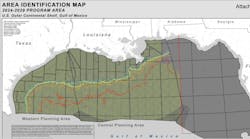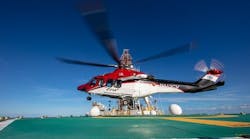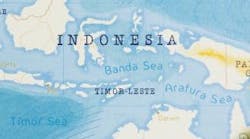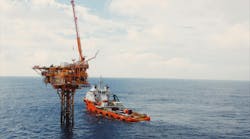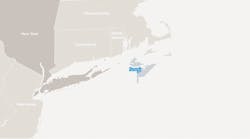Clinton Again?
When US President Bill Clinton took office four years ago, US crude oil production was down by more than 2 million b/d and foreign oil imports were costing the US more than $160 million a day - more than $50 billion a year, or over half the US trade deficit. The US oil industry was beleagered on all sides, with countless companies ceasing operation, hundreds near bankruptcy, and more than 440,000 jobs exported to more hospitable countries.Since those dismal days of 1992, President Clinton has established numerous policies to reinvigorate the domestic petroleum industry and propell the development of additional reserves, to reduce foreign oil imports and not only improve the climate in the United States for renewed exploration and production, but to pave the way around the world for US operating and service companies to participate in the petroleum industries of scores of countries.
President Clinton lifted the long-term ban on export of oil from Alaska's North Slope and has renewed lease sales for Beaufort Sea concessions. He broke with past administrations, too, by supporting royalty relief for Gulf of Mexico deepwater production, which has resulted in a major program of Gulf deepwater exploration and development. He has encouraged gas as a clean energy source, which has been a primary cause for improved gas prices and the almost constant growth in gas field developments in Texas and Louisiana transition zones. His release of major prospective tracks in the most recent Gulf of Mexico lease sale resulted in historic numbers of bids received and tracks awarded. And he has supported numerous measures to reduce or eliminate unfair and unnecessary regulations.
As a consequence, the US petroleum industry has made a remarkable recovery and now stands at a decade-high. All Gulf of Mexico offshore drilling rigs are effectively employed, and service and supply companies are frequently booked through 1998.
In 1992, we stated that then Governor Clinton showed all signs of being pro-business and a friend to the petroleum industry, that he would listen to industry needs and be fair in decisions and appointments. Does President Clinton deserve support from the industry for four more years? The record speaks for itself.
France & Afro-optimism
Since becoming president of France, Jacques Chirac has visited sub-Saharan Africa three times, calling on those ex-French colonies that have been making considerable progress in growth and development, especially the oil-producing West African nations, the Congo, Gabon, Cameroon, and C"te d'Ivoire.
Neither US President Bill Clinton nor British Prime Minister John Major have ever visited black Africa.
The difference in attitudes about Africa in France and in the UK and USA is a remarkable commentary on the two spheres of influence - the French strengthening their ties with the continent, particularly the francophone nations, the British and Americans essentially indifferent to Africa.
The French call themselves Afro-optimists and contrast their stance with Anglo-Saxon Afro-pessimism. Their point, that Africa has a promising future, as evidenced by the economic growth of many of West Africa's nations.
Chirac maintains that Africa is on the right track and that France wants to be at the forefront of nations providing aid to propell the growth and development of African nations. He has called for more trade with Africa as a means of supporting its recovery, as well, and is encouraging French oil companies Elf Aquitaine and Total to increase their already prominent role in developing African petroleum industries.
Happy marriages
Joint ventures between internationally operating oil and service companies and indigenous companies in developing countries are a growing phenomena in today's worldwide petroleum industry. And it's becoming more and more prevalent as the governments of those developing countries make local partnerships a requirement for obtaining contracts and concessions.
But how are these marriages of convenience fairing? In a recent study conducted by the World Bank's International Finance Corp., it was determined that few firms would choose a JV if there were a practical alternative, but that these JVs usually prove successful over a period of years. Essentially, it was concluded that both companies need to feel over time that the contributions of each partner are essential to the continued success of the partnership, but that they are fragile affairs and repleat with potential problems that have to be solved if that success is to be achieved.
Problems include:
- Export rights - a difficult issue, since international operators generally want to control exports as a part of their worldwide operations, and indigenous companies may very well have entered the JV with an eye on increasing their exports. Usually this can be accommodated in production sharing agreements.
- Tax issues - ordinarily such JVs are taxed differently from international operators working alone in the host country, most often at a lower rate.
- Technology transfer - frequently the prime motivation for the indigenous company to enter the JV, thus if expectations for new technology are not met, problems arise.
- Dividend and investment policies - if not spelled out in the agreement, this can be very difficult to resolve. The international operator may have global investment programs and wish to transfer funds from one region to another, or it may want to re-invest dividends in the JV rather than take them; both could cause disagreement with the local partner.
- Differences in partner size - the local partner is most often smaller than the international operator, which can cause difficulties if the local partner can't come up with expansion funds during high growth periods.
- Ownership problems - will emerge quickly if the operational management of the JV is not independent of both partners, and isn't specified from the beginning.
- Control problems - management problems that usually arise because conditions have changed since the JV was formed, or because of disagreement on sourcing equipment and supplies.
- Cultural problems - at least some cultural strain can be expected, because the different partners see circumstances in different ways. A patronizing attitude must be avoided. Perceived corruption as normal business practice can also lead to considerable contention and should be handled with great delicacy..
- Changes in the relationship - refers back to the first point, in that both partners must continually see contribution to the partnership by both parties, no matter how the enterprise changes.
Briefs. . .
Africa
Gabon has granted its 2.4 million acre Gryphon Marin Block to Amoco and Phillips in an exploration and production-sharing contract. Amoco will serve as operator. A 500 sq km 3D survey and reprocessing of 2D data will be carried out. The block is a continuation of the subsalt play in nearby Phoenix Block, which Amoco is now evaluating. Irish independent, Tuskar Resources, has acquired a 40% working interest in Allied Energy's OML 110 off Nigeria. The block contains the Obe Field and several other potentially oil-bearing structures. The shallow-water Obe Field produces 5,350 b/d from two wells. Congo's deepwater Mer Profonde Nord Block has been awarded to Exxon. The 1,540 sq mile area, some 50-75 miles offshore, has water depths to 6,600 ft. Exxon plans seismic before the end of the year. Equatorial Guinea's mighty Zafiro Field continues to be revealed. Already extended north and south by the original wells, Opalo and Topacio wells, the field is now shown to be a single reservoir by the eighth and latest well, Amatista-1. Two other sands encountered indicate the presence of gas as well.Mideast
Abu Dhabi National Oil Co. has spudded a well on its the UAE's Block II in the Nahr Umr Formation to test whether there may be a southerly extention of Qatar's South Field A Structure into Abu Dhabi waters. Iran's current effort to encourage foreign oil companies to invest some 11 billion in 11 oil and gas projects, despite a US embargo and laws to punish such investors, is paying off. Malaysia's Carigali has just invested US$600 million in Iran's Sirri Field in the Persian Gulf, which is being developed by Total. The field is set to begin production in 1998 at 120,000 b/d oil. British Gas has completed drilling two wells off Yemen's Socotra Island, in the Gulf of Aden, where it holds a 17,500 sq km block in partnership with ONGC. The block is now under technical review.Europe
Russia's Rosshelf and Gazprom have awarded Geco-Prakla and Sevmornefte-geofizika a contract for the first 3D seismic survey to be acquired in Russian waters. The survey, of the Prirazlomnoye Field in the arctic Pechora Sea, will cover some 225 sq km. The field is currently under evaluation for development by Rosshelf and partner BHP.Asia
Japan has launched an exploration project for methane hydrates on the seabed surrounding the country. (Methane hydrates are crystaline combinations of methane and water formed on the sea bottom under low temperature and high pressure.) Japan National Oil Corp. is conducting a seismic survey off Hokkaido Island and will drill test wells in two locations in 1999. Commercial production is expected to start in 2010. Estimates are that 6 trillion cu meters of methane hydrates encircle Japan. India's latest decontrol incarnation is proposed by the government to be in three phases, with E&P to follow refining and marketing last in a six-year program. As a consequence of this vacillating policy stance, foreign investment has all but ceased in the country's offshore sector. India's Ravva Field has reached 35,000 b/d, its target production level. Five wells were drilled and tested between 6,000 and 9,000 b/d. Two additional wells will be drilled for another 12,000 b/d in production..A production platform is to be installed before the end of the year. China's Bohai Bay will be drilled deeper by Shell Expro. In a new contract with CNOOC, Shell will probe several possible large reservoirs in deep zones well beyond the usual 12,000 ft TD in the Qingshui Block, location of China's third largest producing field. In the South China Sea, CNOOC has granted a two-year extention to Crestone Energy for its Wan'An Bei, WAB21 contract, following extensive seismic and stratigraphic study of the prospectivity of the 6 million acre track. Crestone plans additional seismic to complete its contract obligation prior to the optional drilling phase. China's offshore output is expected to reach a record 14 million tons of crude oil this year, according to CNOOC, an increase of 6 million tons over last year. The country will also produce 3 billion cubic meters of gas from its offshore fields this year.
Americas
Mexico is taking another look at its northern petroleum play. PGS Exploration has been contracted to shoot a 3D seismic survey offshore Tampico. The 1,470 sq km survey area is obstructed by three production platforms. Another survey of the Saja de Oro area off Tuxpan will follow. Trinidad & Tobago has announced the third phase of its bidding round. On offer are nine blocks located in deep water off the east coast of the islands. Closing date for submission of bids is January 31, 1997. Oil was discovered off Trinidad by Amoco recently, with an exploratory well on its East Mayaro Field. The well flowed 3,700 b/d oil and 64 million cf/d gas from two deep zones. It was the sixth discovery in six wells drilled by Amoco since 1995. Brazil's Petrobras state oil company has begun a campaign to determine the most prospective blocks in the Campos, Santos, Espirito Santo, Sergipe, and Alagoas Basins before the first round of bids for E&P concessions is called. A new seismic survey program is being launched to define a drilling plan for the next three years.Copyright 1996 Offshore. All Rights Reserved.
